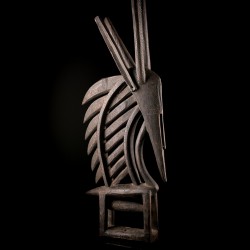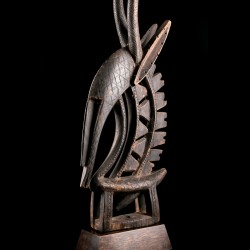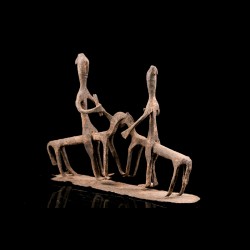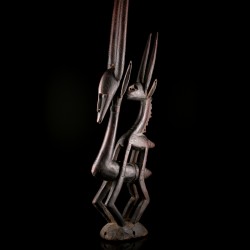


























Crest mask representing a male antelope in Bambara art: as seen in the contextual photos, these masks called ci wara or tyi wara were worn on the head by dancers wearing them in pairs during the sowing festivals and harvests. These stylized animals had the role of ensuring the fertility of the soil and the richness of the harvest.
The roan antelope, much appreciated by the Bambara in Mali, is featured on the crests worn by the dancers recounting the myth of the first farmer. These come out during initiation dances introducing the young men into the eponymous company tyi'wara. The ci wara are released by male-female pairs. We recognize the latter by the presence of a small on its back.
These traditional masks also symbolize the sun and the moon respectively, so it is best not to come between them. This one presents a style typical of the Ségou region with its elongated facies and its imposing detailed headdress, all in verticality.
Data sheet
You might also like

Crest mask representing a male antelope in Bambara art: as seen in the contextual photos, these masks called ci wara or tyi wara were worn on the head by dancers wearing them in pairs during the sowing festivals and harvests. These stylized animals had the role of ensuring the fertility of the soil and the richness of the harvest.
The roan antelope, much appreciated by the Bambara in Mali, is featured on the crests worn by the dancers recounting the myth of the first farmer. These come out during initiation dances introducing the young men into the eponymous company tyi'wara. The ci wara are released by male-female pairs. We recognize the latter by the presence of a small on its back.
These traditional masks also symbolize the sun and the moon respectively, so it is best not to come between them. This one presents a style typical of the Ségou region with its elongated facies and its imposing detailed headdress, all in verticality.



